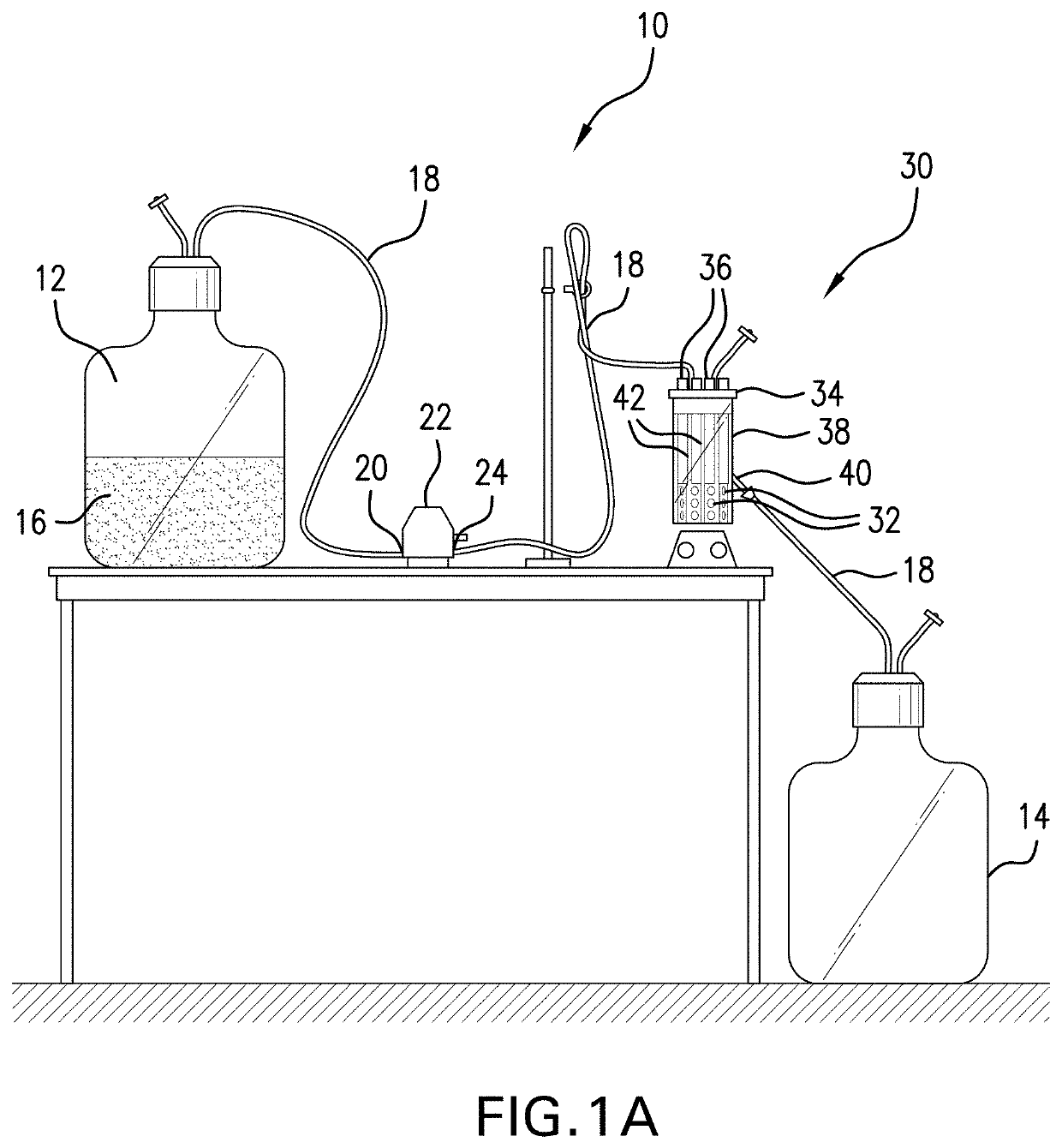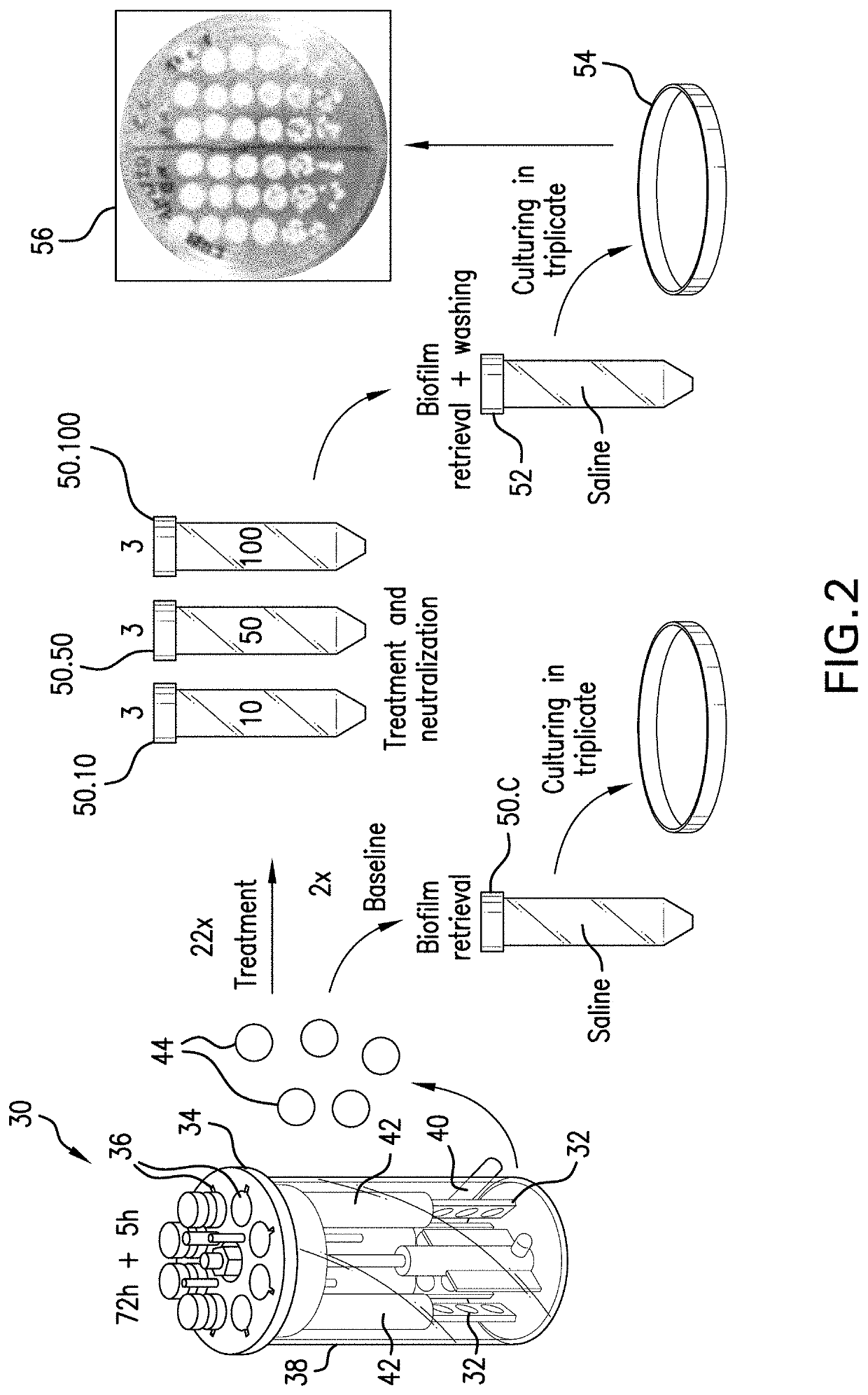Antibiofilm Compositions, Wound Dressings, Cleaning Methods And Treatment Methods
a composition and composition technology, applied in the field of compositions with antibiofilm activity, can solve the problems of biofilm growth, biofilm on the surface is injurious to human health and destructive to property, antibiotics generally are ineffective against bacteria in biofilms which have reduced metabolic activity,
- Summary
- Abstract
- Description
- Claims
- Application Information
AI Technical Summary
Benefits of technology
Problems solved by technology
Method used
Image
Examples
example 1
General Bacterial Biocidal Activity
[0133]Example 1 is testing having the objective of determining as a general matter (i.e, not bacteria in a biofilm) the antibacterial efficacy of an antibiofilm composition comprised of about 0.10% (w / w) benzalkonium chloride; about 0.50% (w / w) phenoxyethanol; about 0.20% (w / w) 3-(tri-methoxysilyl)propyldimethyl octadecyl ammonium chloride and about 99.2% (w / w) deionized water. The testing methodology is in accordance with BSEN 1276. The test involved the preparation of a standard suspension of test organisms containing 1.5-5.0×108 cells per ml (milliliter) of the following four standard bacteria: Escherichia coli K12 NCTC 10538, Enterococcus hirae ATCC 10541, Pseudomonas aeruginosa ATCC 15442, Staphylococcus aureus ATCC 6538 and Salmonella typhimurium ATCC 13311.
[0134]In overview, the test procedure was as follows. A sample of antibiofilm composition was delivered or diluted to a test suspension of bacteria in a solution of an interfering substanc...
example 2
General Bacterial Biocidal Activity
[0137]Example 2 is an evaluation of the general activity (not bacteria in a biofilm) according to PN-EN 13727+A2 of an antibiofilm composition comprised of about 0.10% (w / w) benzalkonium chloride; about 0.50% (w / w) phenoxyethanol; about 0.20% (w / w) 3-(tri-methoxysilyl)propyldimethyl octadecyl ammonium chloride and about 99.2% (w / w) deionized water. The test method was dilution-neutralization. The antibiofilm composition diluent in the test was distilled water. Concentrations tested were 1%-97% v / v (percent by volume.) The interfering substance was 0.3 g / l (grams per liter) bovine albumin. The test temperature was 20.0° C.+ / −1.0° C. (degrees Celsius.) The contact time was 60 s+ / −5 s (seconds.) The incubation parameters were 37.0° C.+ / −1.0° C. (degrees Celsius,) 48 h (hours) and pour plate method. The microbial strains in the test were Pseudomonas aeruginosa ATCC 15442, Staphylococcus aureus ATCC 6538, Enterococcus hirae ATCC 10541 and Escherichia co...
example 3
Mature Biofilm Growth on Coupons
[0139]In this Example 3, mature biofilms were established on polycarbonate coupons (32) using a CDC biofilm reactor (30). Determinations in Example 4 herein used these mature established biofilms on polycarbonate coupons.
[0140]Referring to FIGS. 1A and 1B, there is illustrated a CDC Biofilm Reactor (30) by Biosurface Technologies Corporation (Bozeman, Mont., USA) (CDC-BR) situated in an operational setup (10). Referring to FIG. 1A, the operational setup (10) for a CDC-BR (30) is comprised of a first tank (12) (also called a medium tank) holding circulation medium (16); said first tank (12) is in fluid communication via tubing (18) with the inlet (20) of a pump (22) having an outlet (24); the outlet is in fluid communication via tubing (18) with ports (36) in a ported lid (34) of a reactor vessel (38) having a lower outlet (40) and the lower outlet (40) is in fluid communication via tubing (18) with a second tank (14) (also called a waste tank) for hol...
PUM
| Property | Measurement | Unit |
|---|---|---|
| melting point | aaaaa | aaaaa |
| vapor pressure | aaaaa | aaaaa |
| boiling point | aaaaa | aaaaa |
Abstract
Description
Claims
Application Information
 Login to View More
Login to View More - R&D
- Intellectual Property
- Life Sciences
- Materials
- Tech Scout
- Unparalleled Data Quality
- Higher Quality Content
- 60% Fewer Hallucinations
Browse by: Latest US Patents, China's latest patents, Technical Efficacy Thesaurus, Application Domain, Technology Topic, Popular Technical Reports.
© 2025 PatSnap. All rights reserved.Legal|Privacy policy|Modern Slavery Act Transparency Statement|Sitemap|About US| Contact US: help@patsnap.com



